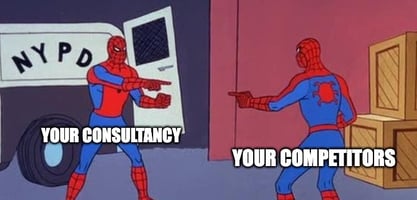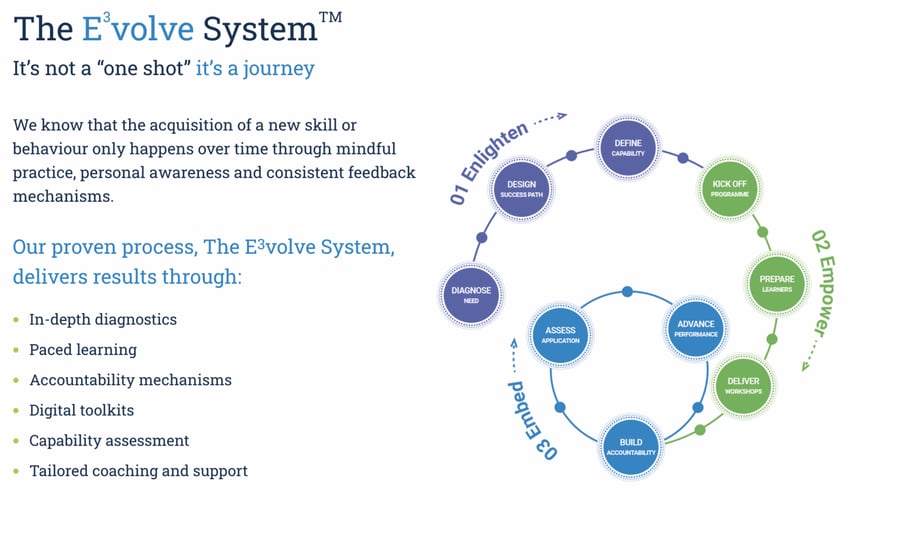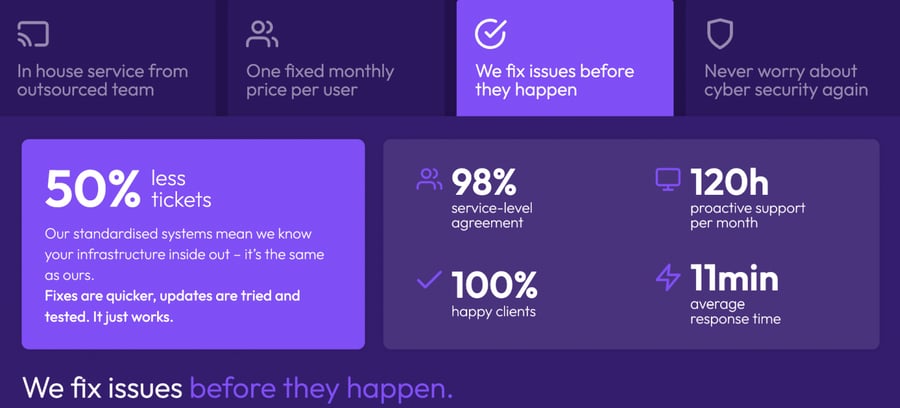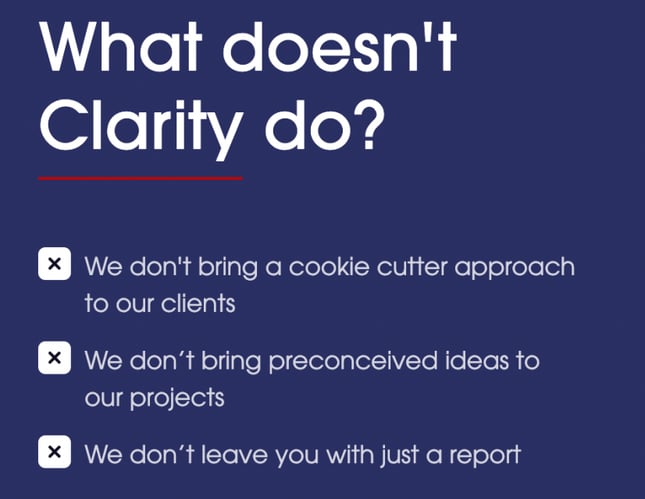EVERYTHINg YoU NEEd To KNoW ABoUT PoSITIoNINg STRATEgIES
Every consultancy wants to be more than its competitors. But most fail to own their position in an oversaturated market. Without the right strategy to guide them in identifying and owning their unique strategic differentiators, the results can be a bit… meh, leaving them looking, sounding and feeling like every other consultancy in their sector.

Clearly, being ‘meh’ just isn’t going to cut the mustard. By carving out — and protecting — your niche, you can stand out from your competitors, weave a story that resonates with potential customers and get prospects talking about you like this:

So, how do you avoid being yet another Spider-Man and have clients go totally gaga for your consultancy?
This guide delves into the intricacies of creating a successful positioning strategy, provides advice tailored for the consultancy sector and explores tools you can begin implementing today.
Before we dive into the good stuff, here are three reasons why you should read this guide:
- We know what we’re talking about. This guide is written for consultants by experts who have advised more than 200 firms over the past 13+ years and helped 30+ consultancies achieve differentiated positioning in the past 24 months.
- We talk (and write) like real people. You won’t find any unnecessary jargon in this guide. We’ll explain everything in terms that’ll make sense to humans.
- It’s full of ideas, tools and examples. We don’t gatekeep information and certainly haven’t skimped on any details. That means we’re sharing tips and tricks you usually have to spend thousands to access.
The foundations of positioning
What does 'positioning' actually mean for consultancies?
In the world of consulting, ‘positioning’ refers to the process of devising and marketing a unique and memorable identity that potential clients will perceive as valuable.
Good positioning is essential for consultancies wanting to carve out a clear niche that resonates with and attracts their target clients. There are countless factors consultancies can base their positioning on, including their expertise, services, outcomes and more.
In simple terms, positioning is using everything at a company's disposal to strategically shape a prospect's perception of them. When done correctly, positioning goes above and beyond marketing tactics (though copywriting and design are a critical part of the process), encompassing culture, employee retention and many other factors that influence a company’s perception amongst its target audience.
Positioning vs. differentiation
If you’re well positioned, it doesn’t mean your consultancy is differentiated, and vice versa. So, what’s the difference between positioning and differentiation?
-
Positioning is how your prospects perceive you. You can think of it as the lens through which your ideal prospects and buyers see your value proposition. If their prescription is correct, you deliver great clarity and understanding, winning high levels of attention, curiosity and intrigue. If you’ve got their prescription wrong or their lens is foggy and scratched, prospects will only see misunderstanding, confusion and… tumbleweeds. But more on all that in a minute.
-
Differentiation is all about standing out from your competitors by offering better onboarding experiences, performances, results — the list goes on (and on and on and on).
Why positioning is important
Nail your positioning, and you're not just hitting the bullseye – you're splitting the arrow that's already there, winning your consultancy fantastic commercial impact. And when your positioning is poor? Well, you can spend thousands upon thousands on marketing and lead generation campaigns — and end up with a big, fat nothing in return for your efforts.
You’re probably thinking, ‘wha-what?’ We’re taught that if you chuck money at your campaigns, they have to pay off — this is a lie. A good marketing campaign will direct people to your website, but what then? You need effective positioning that proves your consultancy’s value and resonates with potential clients. And if you don’t? Well, those potential clients have no reason to stay on your website, let alone find out more.
In other words, being well-positioned will get you:
- Eyeballs. When done right, positioning and messaging can catapult your brand awareness to unimagined heights. Think of positioning like a loudspeaker capable of laser-focusing on the ‘best fit’ clients who will guarantee you success and profit. They hear your message LOUD AND CLEAR.
- Great-fit prospects. Having all eyes on you hardly matters if they’re the wrong eyes. That's where intelligent messaging comes in. By crafting a narrative that speaks to your target audience and resonates with their challenges, you can maximise your consultancy's visibility and attract clients who truly appreciate its unique value.
- Better client retention. Good positioning = better-fit clients = better retention. Move over, Girl Maths; TGO Maths is here. When your positioning is water-tight, prospects can self-qualify based on your process and values before they’ve even met with your team. This reduces the risk of relationship breakdowns due to mismatched ideals. Just think of the heartache you could save yourself by laying your cards out before the first date.
- Unlock premium pricing... without hesitation. A winning position lets you command higher prices with less resistance, resulting in more wins and better profits. Good positioning not only elevates your consultancy’s perceived value above your competitors’ but puts you in a category of your own, where you own a larger piece (if not all) of the pie.
- Bigger, better clients. If you want to rub shoulders with the big industry players, great positioning has the power to secure you those game-changing coffee meetings.
- Opportunities. The more people who perceive you favourably, the more you’ll get spoken about offline and online. You can discover a whole host of investment, partner and M&A opportunities through word of mouth.
We doubt you need much more convincing on the benefits of positioning, but for the sake of balance, here’s what being poorly positioned will win your consultancy:
- A reliance on referrals. Great positioning is like putting a big neon sign above your shop that says, ‘HEY, WE’RE OVER HERE, AND WE’RE BRILLIANT!’ Without any signage, customers will only find you if others point them in the right direction. And you’ll scrap to find that next sale.
- Missed opportunities. When you lack a compelling message, potential clients will overlook you in favour of competitors who’ve mastered their narrative.
- Low conversions. ‘This is exactly what we need.’ Everyone wants to hear those all-important six words at the end of a sales call. When you lack effective positioning, you’ll find yourself defending your consultancy to prospects more often than not.
- Competitive prices. You never want to be competitive on price. If the only reason your consultancy makes sales is because you’re the lowest bidder, customers perceive you as a commodity, not as anything special.
Refining your positioning is an investment in your firm's future growth, putting you in your prospects’ line of sight. By crafting a market position that resonates deeply with your ideal customers, you build a foundation for sustained success, credibility and market leadership.
You should fix your positioning if...
You may be wondering when the right time to refine your positioning strategy is. Most leaders assume that positioning is a start-up phase task, but the best time to position your business is NOT at inception.
It’s not as simple as jotting down a value proposition, waving it into your marketing materials and pressing ‘go’. Instead, you want to start defining your positioning and messaging only once you have a proven business model and an innate ability to sell your expertise. If your market is proven and you’ve experienced success with a few ideal clients, you can ‘retrofit’ your positioning. This will help you consistently and regularly connect with more of your dream clients.
And what happens when your messaging goes stale, leaving your voice lost in the chorus of the competition? Growing a consultancy isn’t easy, with ‘Fix Positioning’ lingering at the bottom of the priority list somewhere between ‘Update Zoom background’ and ‘Revamp capabilities deck’. But when you begin experiencing any of the following signs, it’s time to think about hitting reset:
- Dwindling or zero lead generation
- The feeling of being a marketplace 'clone'
- Getting ghosted across channels
Market dynamics for consultancies
You wouldn’t run into a deep, dark wood without a map or your glasses. That would be almost as silly as jumping into a new market feet first without researching the market dynamics.

Understanding market dynamics is critical when devising a robust positioning strategy. They provide insights into ever-changing consumer preferences, technologies and competitive forces, which will inform your strategy and make sure your consultancy stands out — rather than fits in.
Understanding the competitive landscape
Without a firm understanding of the competitive landscape, you can kiss effective positioning and powerful differentiation goodbye. By identifying where your consultancy currently exists in relation to the competition, you can uncover untapped niches, note what’s already being done and map out a path to success.

Competitor analysis
Pull out your spy glasses and stick-on moustache — it’s time to go undercover and assess the competitor landscape. By completing a SWOT analysis that outlines your competitors’ strengths, weaknesses, opportunities and threats, you’ll identify potential market advantages and areas of differentiation to leverage.
Market gap analysis
Untapped opportunities, here we come! Market gap analysis can help reveal unmet customer needs, underutilised technologies and more. Your next mission? To seize these opportunities. Here’s how:
- Identify market offerings. Gather the market insights you collected while undercover. What are your competitors doing? Who are the major players in your market? What are their USPs or their perceived points of difference?
- Customer feedback. Talk to your current clients; their insights may reveal unaddressed needs or desires you can take advantage of.
- Spot the gaps. You may find that the market you’re currently operating in is overcrowded, which makes your task of differentiating your consultancy ten times harder but also ten times more pressing! If you’re willing to take a risk, you can position your consultancy in a different market entirely. What matters most is being noticeable, so whether you’re a big fish in a small pond or a small fish in a vast, deep ocean, if you suddenly grow legs and walk on land, all eyes will be on you.
- Evaluate the potential. If you discover a gap in the market, lucky you! Now, you need to assess its potential. Not all market gaps will be viable or profitable. Make sure it has a healthy market size and growth prospects before taking the leap. There’s nothing worse than diving into a swimming pool and finding it’s 10cm deep.
- Define your strategy. The information and insights gathered during this process will help you create differentiated messaging that resonates with your target market.
Positioning strategies for consultancies
That heading might be enough to break you out in a rash, as traditional positioning strategies are typically overly complex and difficult to use. Fortunately, we prefer teaching non-traditional positioning strategies that are simple to understand, easy to implement and proven to create positive perceptions.
This process begins and ends with your positioning proclamation: a written declaration of your consultancy’s value proposition and target market. Think of your positioning proclamation as a single truth source representing your business’s identity and value, ensuring your team sings from the same hymn sheet when engaging in all interactions.
At Total Growth Ownership, we believe there are six (and a half) essential components of a consultancy positioning proclamation. You can weave a unique and captivating narrative by leveraging a different…
1. Unique Mechanism
Do you have a unique process, tool or approach that sets you apart from your competitors? If not, you need one. We call this the ‘unique mechanism,’ a method or process which showcases what your consultancy has to offer in a unique way.
There are three different types of unique mechanisms:
- The existing mechanism. If your business has a legitimately unique offering, such as a patented product or algorithm, you can leverage this as part of your positioning. You’re unlikely to fall into this bucket, but we’ve included it for completeness.
- The unspoken mechanism. Most consultancies don’t like to let clients see how the sausage is made, as it were. But what if you used that to your advantage? Whether it's common practice or a regulatory requirement, any process or practice you follow that isn’t well-known to prospects can be turned into a key differentiator. All you need to do is shout about it!
- The transformative mechanism. Possibly the easiest on our list to implement (after all, not all companies own a patent or have an unspoken rule to leverage). The transformative mechanism can put your consultancy on the map by transforming its core process into a clear visual. This means naming the process something memorable and giving each step a title. We like it when our clients’ mechanisms follow clear steps that are alliterative or spell a relevant acronym.
With the help of compelling branded graphics, you can transform your unique pathway to results into a visually digestible format by creating compelling branded graphics.
Here's The Win Academy's unique mechanism: their E³volve System™. It showcases their value proposition in a unique, digestible, neatly packaged way, going from a linear direction (01 Enlighten > 02 Empower) into a repeating cycle (03 Embed).

By way of contrast, our client at ProjectPartners had an existing unique mechanism: “The ABCDE Way”. Whilst this methodology has more steps and alternative routes to completion, it is packaged in such a way that clients are easily able to follow the process, and understand what to expect at each stage.

2. Quantifiable result
Everyone loves data! And if they don’t, they should. Because numbers speak louder than words when it comes to building trust, you should back your consultancy’s claims with hard data. For example, reveal what quantifiable improvements you can promise within 90 days.
Here’s how using evidence-backed claims can look in practice. By encouraging Singularitee, which offers managed IT solutions, to lay all their cards on the table, we helped prove their value to prospective clients through quantifiable results.

Another example by our friends at Waymark demonstrates that they guarantee a user-tested, interactive digital prototype in 30 days. Imagine the confidence from your sales guys and gals if they could make a similar declaration in their pitches.

3. Category owned
Claim your turf by creating your own niche. By positioning yourself as ‘the world’s only…’ in this new category, you provide a distinct benefit and dominate the space. And because there are no competitors to compare yourself to, this strategy is all about positioning and not about differentiation.
Here are three of our favourite examples:
- The world’s only corporate innovation engineers.

2. The world’s only enterprise tech catalyst.
3. The world’s only flow of work accelerators.
When prospects think of this niche, they think of you - and only you. In other words, you get the whole pie to yourself!
Brilliant, right? Just make sure to run a quick Google - otherwise known as a “googlewhack” - to make sure it’s unclaimed, or it’ll all come crashing down.
4. Language library
Rather than blending in with industry jargon and overused buzzwords, why not stand out by crafting your own terminology? By combining a pinch of creativity and a touch of strategic thinking, you can create a new language of sorts that uniquely describes:
- How your prospects feel
- Your solution's outcomes
- Your people
- Your marketing assets
Devising new terminology aligned with your values will help your consultancy stand out and pique your target audience’s interests. When compiled, these terms form ‘bible’ used to create cohesion across your communications.
For example, our client Capacitas no longer promises to deliver ‘confidence’ but ‘Cloud Confidence’.

This is a great opportunity to be creative and capture the attention of your great fit prospects.

5. Invalidate Alternatives
Invalidate your competitors’ marketing plans. Seriously. By challenging common notions, you present your prospective clients with a clear choice - you!
What does this look like in practice? We helped Clarity connect with their ideal client by allowing prospects to disqualify themselves before booking a call. A simple invalidation statement outlined Clarity’s values and ways of working, helping potential clients determine their own compatibility and ensuring their team only spent time nurturing qualified prospects. A prospect deciding ‘this isn’t for me’ is just as valuable as a ‘this is for me’ response.

By contrast, FutureFoundry took an “us vs. them” approach to their competitor invalidation.

6. Risk removal
Go the extra mile and align your consultancy with your clients’ needs. Prospects love it when consultancies offer guarantees that minimise (or eradicate) the perceived risk of partnering with them.
Get ready to be inspired by how Waymark had fun with risk removal. They created the Millennium Moonwalk Guarantee, offering to refund their workshop fee IN FULL if their clients aren’t 100% happy with their prototype or — in their words — if they wouldn’t ‘moonwalk the entire span of the Millennium Bridge’ to keep hold of it.’

Our clients at Prospectus also back themselves, offering a money back, no questions asked guarantee.

6.5. Rallying cry
Finally, our bonus .5: an addition inspired by sales guru Jeffrey Gitomer.
We believe every brand has something they ardently stand for or against. Clients want to know what you stand for, so speak up about your causes. Just make sure to mirror your target prospects’ values, as a mismatch between your consultancy’s ideals and your clients’ can lead to cognitive dissonance. Such dissonance destroys trust and can erode your strategy's efficacy, rendering your efforts wasted.
For example, at TGO we strongly believe that positioning should be fixed before any more budget is thrown at marketing campaigns or to marketing agencies. Otherwise, you’re wasting time and money marketing a message that hasn’t been validated and doesn’t resonate. So whilst the title of this newsletter article put a few noses out of joint - enough of our audience vehemently nodded in agreement.

Similarly, our client in Czechia, Colours of Data, came up with this rather comical and scroll-stopping rallying cry.

Strategy execution for consultancies
The time has come to stop the strategising and put your plan into action. Breathing life into your new positioning is all about communicating and embodying the values, personality and offerings you’ve identified throughout this process in every facet of your consultancy. Here’s how:
Aligning with prospects’ attitudes and challenges
Your messaging brings your positioning to life. But it’s just window-dressing if it has no depth behind it. Your brand must represent your positioning by aligning in a way that makes sense to clients. For example, if your consultancy’s core value is innovation, your brand must embody an open-minded attitude.
Written elements, such as taglines, website copy and tone of voice — a crucial element for consultancies — mirror the nuances of your audience’s specific challenges.
Creating consistency
Taking steps to unify your brand’s messaging will create a consistent experience for all clients interacting with your consultancy.
From your team’s LinkedIn profiles to your email signatures, every marketing asset must reflect your updated positioning. By creating a consistent verbal identity, you can ensure your consultancy’s unique value proposition is immediately recognisable and memorable, establishing true differentiation in the market.
Position activation
Embodying your positioning goes beyond the service you offer. Remember that massive neon sign we mentioned earlier? Leveraging your highly resonant, consistent messaging across platforms will create an unshakeable prospect perception and help guide the right people to your door.
This covers:
- Your digital presence. Use consistent visual and written assets across your digital footprint, including your website, social media profiles, email signatures and more.
- Offline communications. Think about how else clients may engage with your business. Will they visit your office? Pick up brochures? Take your business card? Everything should echo your positioning.
- Training. While the consistency of digital and printed communications can be encouraged with a handy brand guideline, additional training will ensure every team member, from finance assistants to consultants, can articulate the brand’s positioning.
Feedback loops
You can’t ‘set it and forget it’ when it comes to positioning — especially in the fast-moving consultancy world. Feedback loops hold you accountable for fixing inconsistencies or refreshing your positioning when it no longer serves its purpose. Take your finger off the pulse, and you might as well hand your best clients over to your competitors and thank them for the privilege.
As it’s easy to become complacent about your messaging, feedback loops shouldn’t rely on internal perspectives. It’s crucial you talk to clients and third-party experts, as they will be brutally honest with you.
Internal feedback loops:

Your clients’ honest feedback:

Taking the time to understand what's working for your clients and what's not can provide invaluable insights into potential positioning refinements. Then, internal reviews allow you to dig deeper, checking if your positioning aligns with the market’s needs and your consultancy's evolving capabilities.
Remember: positioning isn’t static. Use this feedback to evolve your messaging as your consultancy grows and markets shift.
Effective positioning strategy checklist for consultancies
Now that we’ve gone through the whole process of planning and executing your positioning strategy, let’s summarise the anatomy of an effective positioning strategy.
- Self-awareness. Ask yourself, what sets your consultancy apart? By forming a clear positioning proclamation, you outline how you want your target audience to perceive you.
- Relevance. Positioning is about ensuring any claim you stake resonates with customers. Does your strategy align with their challenges and needs? It’s important to understand the buyer’s pace by recognising where they are in their journey and presenting yourself as the bridge to where they aspire to be.
- Uniqueness. Clients have watched endless pitches and scrolled through countless websites. So, your consultancy needs to stand out. Save time and effort for your clients by making it easy for them to notice you.
- Consistency. Maintain a clear and uniform positioning message across all marketing platforms.
- Adaptability. Stay agile and adapt your positioning as the market evolves and new players emerge. Even the best growth strategies need to evolve eventually.
- Evidence-backed claims. Support your positioning by peppering your woven narrative with tangible social proof, including case studies, quantifiable results and testimonials.
- Emotional resonance. Consultancies thrive on human connection despite their analytical nature. Your positioning should use statistics, yes, but it should also reflect on the relief, assurance and success your consultancy can bring to clients.
Three pitfalls to avoid:
- Neglecting external expertise. Many consultancies have revamped their messaging internally; few have been successful. While you know your consultancy best, familiarity breeds massive blind spots. External experts bring a fresh perspective and deep knowledge of market dynamics, helping you unearth unique selling points you may otherwise overlook and ensuring your approach is unique.
- Prioritising gimmicks over authenticity. We’ve noticed a worrying and growing trend of businesses leveraging gimmicks to stand out. Excessive promises may catch attention momentarily, but true differentiation isn’t found in superficial stunts. Consultancies looking to create a genuinely effective positioning strategy must go beyond gimmicks and lean into genuine resonance.
- Starting with the website. While it can be tempting to splurge on a brand-new website, a visually striking design is only skin-deep. If, below the facade, your message remains unclear, you’ll have wasted your money. You can think of positioning as a pre-marketing activity; as messaging guides everything from your web copy to email signatures, if you want to overhaul your brand image, you need to overhaul your positioning first.
Key resources for consultancies
Before you get stuck into defining your new position, why not get prepared with our super-handy, super-valuable and easy-to-access list of resources for consultancies? From free training to in-depth books, these resources will help you on your way.
- Free training: Total Growth Ownership founder Matt Hodkinson talks you through how to break through all consultancy growth ceilings for good in this 17-minute training video. Plus, discover how to guarantee a consistent and predictable flow of new clients.
- 60 ways to market your consultancy guide: We believe all marketing easy wins are worth taking advantage of. And we’re serving up 60 on a shiny golden platter: this bumper compendium of tricks, tweaks and actionable nurturing and conversion strategies is free and can be put to use right away.
- The MEHscapology book: In this positioning page-turner, we give you a step-by-step formula for transforming your market presence and core business language. You’ll learn the true cost of bad positioning, the importance of differentiation and how language drives audience perception.

